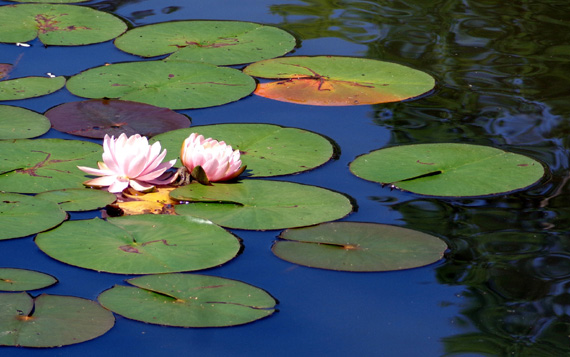Had ya going' there, didn't I?
"Pot" isn't legal in Georgia, even medical marijuana. I'm talkin'
about clay pots and the creative ways I learned that people are
using them in landscape design and other places.
This entry is a continuation of the last one about settling into our
new home in Peachtree City this year. On this page I'm focusing mostly
on the large -- and largely un-landscaped -- back yard we
inherited and what we've done this spring and summer to make it more
appealing.
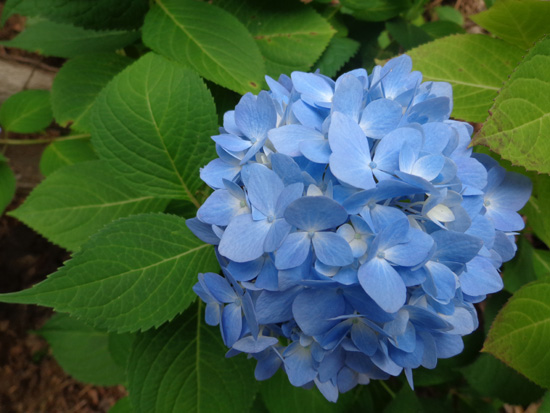
The only flowering shrubs in the
back yard were some small hydrangeas with pretty blue flowers.
Hydrangeas bloom blue in acidic
soil and pink in more alkaline soil.
One of the ways I decorated a section of the back yard is by making a clay pot
person sitting on a garden bench. Until I saw a similar pot person in
someone else's yard along the bike path in our neighborhood, I had no
idea it was such a popular craft.
More about "Susie" later.
ANOTHER GARDEN OF WEEDIN'
When we bought our twelve-acre property in Virginia in 2004 we inherited some large
beds of beautiful perennial flowers.
That wouldn't have been a problem if we'd been there most of the time
and could keep up with maintaining the beds a little bit at a time but
with our extensive RV travel each summer, when we'd return in the fall
I'd have several weeks' worth of weeding to do.
That and dealing with all the fallen leaves from deciduous
trees on the property killed the anticipation of going back to the house
every autumn for ten years.
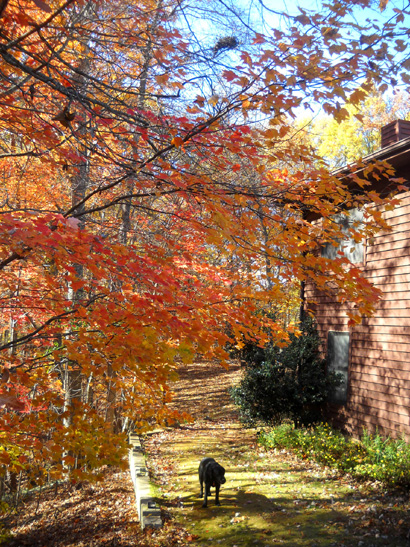
Two photos from our VA property: pretty leaves, but
a lot ended up
in the lawn and gutters. Cody helps me with
weeding, below.
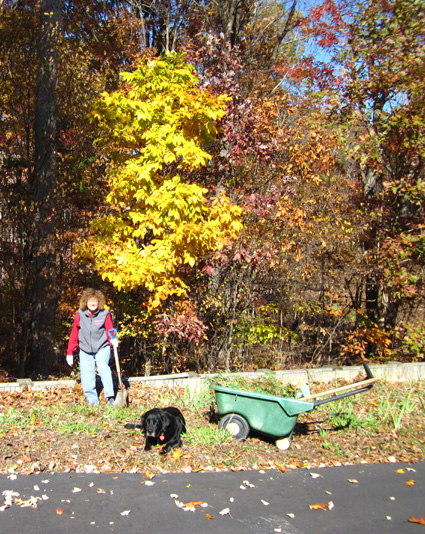
With this house in Georgia, I was hoping for attractive, mature landscaping that
didn't require a lot of work.
We got that on both sides of the front yard, with pretty Drift roses, Chinese fringe
shrubs (Lorapetalum), Grey Owl junipers, and crape myrtle
trees already at full size and just needing annual pruning:
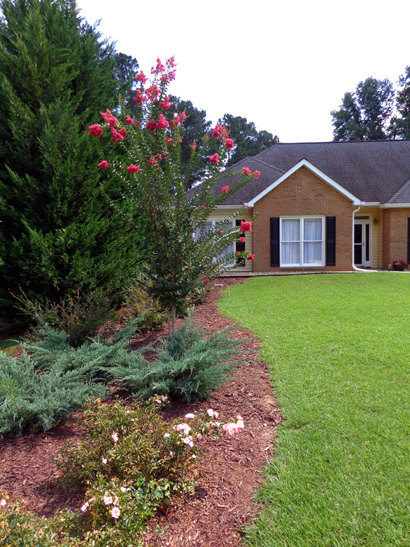
The back yard is a different matter, however.
We've been very busy back there, much busier than we anticipated. Because of my grandiose
landscape plan and several big rainfalls, it's been even more labor intensive than the large
perennial beds and lawns we had in Virginia.
The sellers took out 40+ large trees several years ago and left the back
yard pretty much un-landscaped except for a few small trees, a
nandina bush, a holly, four hydrangeas, a very large and
sparsely-mulched area, and some nice zoysia lawn that turns brown in the
cooler months.
When we saw the house in February we noted the large expanse of wood
chips and pine straw mulch and knew we'd have to replenish it this year.
We didn't realize how many weeds would grow there, however, nor
the erosion problems during hard rains, thanks to them taking out all
those trees.
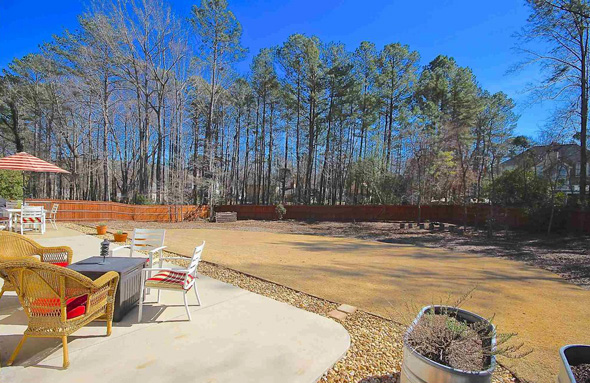
Back yard "before:" MLS shot from back of the house; the zoysia
grass greened up in April.
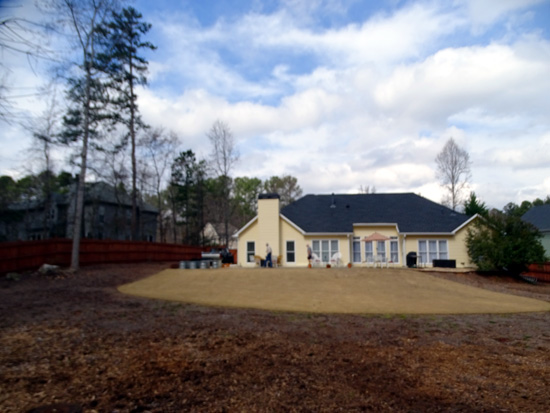
This picture I took on Feb. 21 from near the back
fence gives a better idea of how
much of the back is mulch and not grass-- a least
two-thirds (not all of it shows here).
I love a good landscaping challenge so I viewed the large "blank slate"
in the back yard as an opportunity to plant things I can choose rather
than inheriting something less appealing than my vision. While
waiting to close on the house I drew a detailed-but-tentative landscape
plan with flowering trees, shrubs, perennials, and groundcovers to
fill in the mulched area.
HURRY UP & WAIT
It would have been the sensible thing to do to buy a few of the plants this
spring and fall, then add to them gradually over the years until we had the yard
nicely landscaped.
Sensible for someone younger, maybe, but we're in our late 60s
and I didn't want to wait till I've got one foot in the grave before
seeing the landscape filled in more fully! I've made the mistake in some
other yards of buying new small plants to save money and then moving
before I got to see them get large enough to really enjoy.
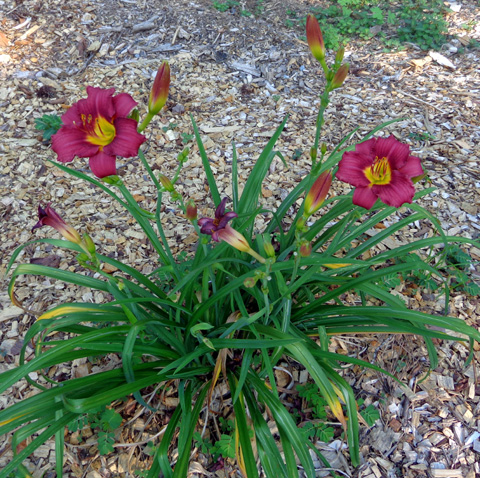
I planted about 15 daylilies in different colors;
they got larger and will multiply.
Since it takes time for plants to mature, I hit the ground running a
couple weeks after we moved in, spending a pile of money, mostly at Pike's
Nursery, on Encore azaleas (which bloom continuously from
spring to fall, not just in the spring), Knockout and Drift roses,
forsythias, viburnums, lantana, barberries, daylilies, coral bells,
hostas, spidorwort, and other shrubs, perennials, and groundcovers that
I've successfully grown previously in the Atlanta area.
The next three photos
are from the end of May, after the first flush of new planting:
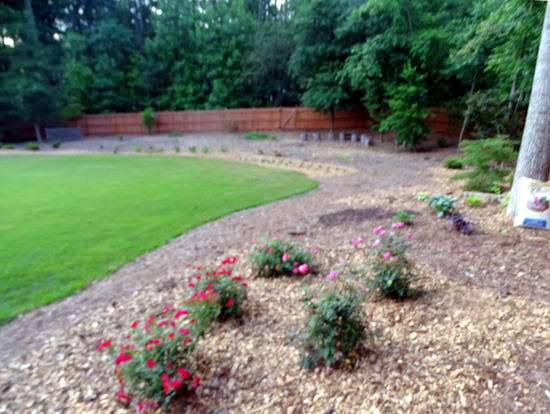
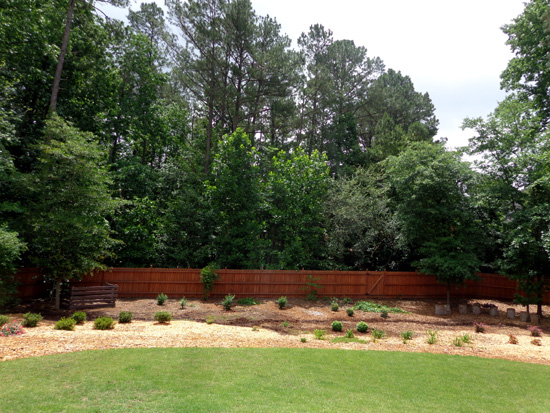
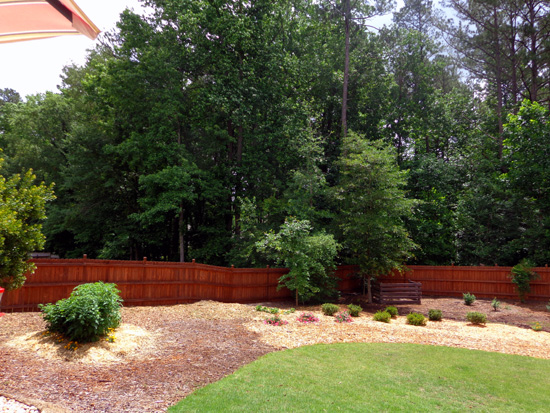
In late September we added a redbud tree and a pink dogwood tree. I'll plant
bearded irises and spring bulbs in October or November.
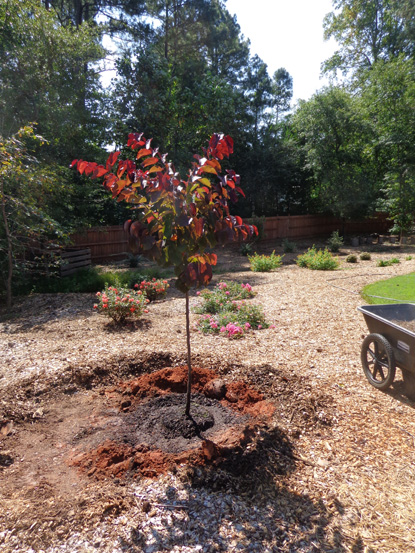
This "Forest Pansy" redbud tree will have
purplish-bronze leaves
year round and pretty purplish-pink flowers in the
spring.
I bought medium-sized plants, not the smallest ones -- although
they look pretty small in these pictures -- so they'll mature
faster and we can enjoy our yard sooner. Digging dozens of holes,
planting everything, and watering frequently during the spring and
summer has been a lot of work but satisfying to me.
We also planted four tomato starts and some herbs in the vegetable
garden and separate strawberry bed the sellers had previously dug:
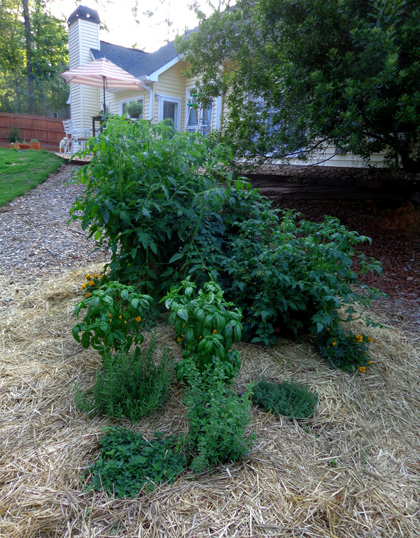
The tomato plants got 'way bigger than we expected;
they were too close
together and already too big for their cages by the
end of May.
WATER, FERTILIZER, TIME, & ATTENTION = LOTS OF GROWTH
Almost everything is flourishing except for a few azaleas that may have
gotten too wet in a low area of the yard and a few perennials that died
from unknown causes (the perennials may come back next spring so I haven't given
up on them yet). All the trees and shrubs from Pike's are guaranteed for
life so they can be replaced at no additional cost, if necessary.
The roses and Encore azaleas have bloomed prolifically and are still
blooming in October, when I'm writing this. All of the plants have grown
in size -- the lantana quadrupled in width and height! --
and some of the perennials and groundcovers have already multiplied.
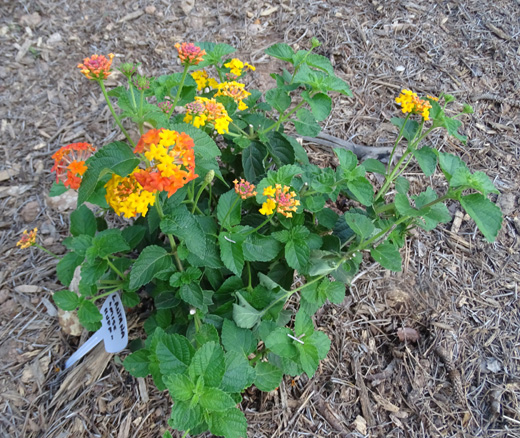
The three lantanas were about 12x12 inches when I
got them (only a little growth on the one
above from mid-May); now the largest is over 3 feet
high and 4 feet wide (below).
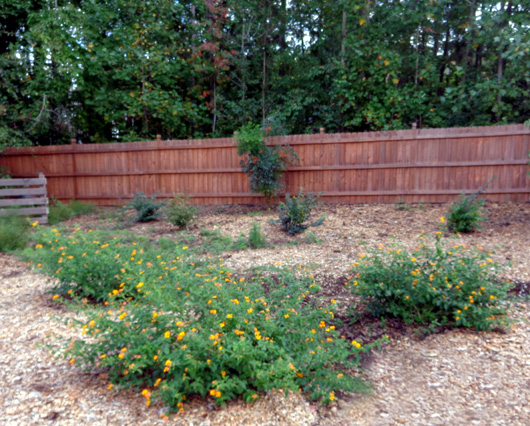
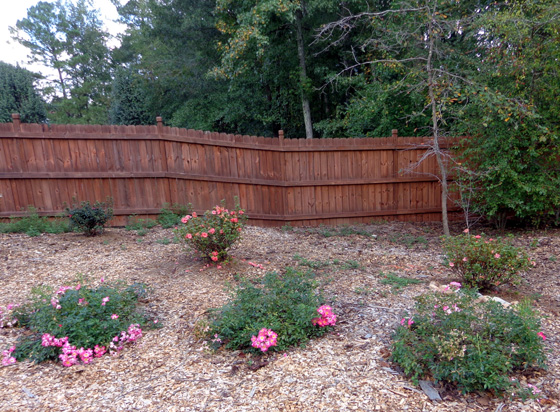
Drift roses in front, azaleas behind; all six drift
roses we planted
doubled in size and bloomed prolifically into late
fall.
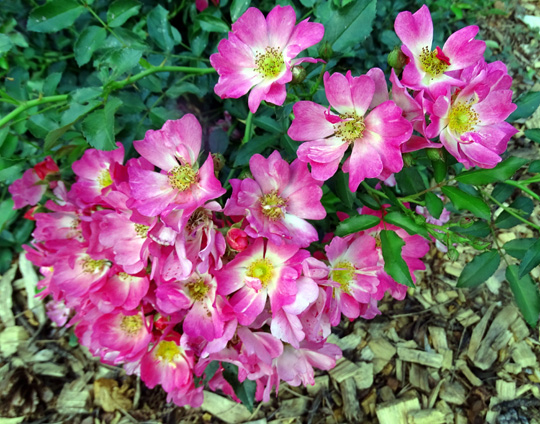
Pink Drift roses
The tomatoes quickly outgrew their cages and peaked in July; we
had enough cherry and large tomatoes to share with neighbors. The basil,
oregano, rosemary, and thyme are also huge. Birds and the dogs have
gotten most of the strawberries. :-)
I guess one thing I
forgot about gardening in Georgia is that with the right plants in the
right place, weather conditions are usually ideal for growing large,
healthy plants. I think we planted the shrubs, trees, perennials, and
groundcovers far enough apart to allow for eventual prolific growth
-- I read the labels carefully re: expected height and width
-- but we'll have to remember to give veggies more room next
year.
One of the things I missed about traveling full-time in our RV was
gardening. Now I'm happy to play in the dirt again! I just don't love
the weeding.
MONSTER MULCH
We knew when we bought the place that we'd have to periodically
replenish the mulch in the back yard with more pine straw and/or wood
chips until we can get groundcovers established.
Soon after we planted most of the shrubs and perennials in the spring we made
a few trips to the city mulching area to load free mulch into the truck.
That took us a long time, was hard on us old folks, and the mulch didn't
go very far. We needed to find another way to do the job at not a lot of
cost and less hard labor.
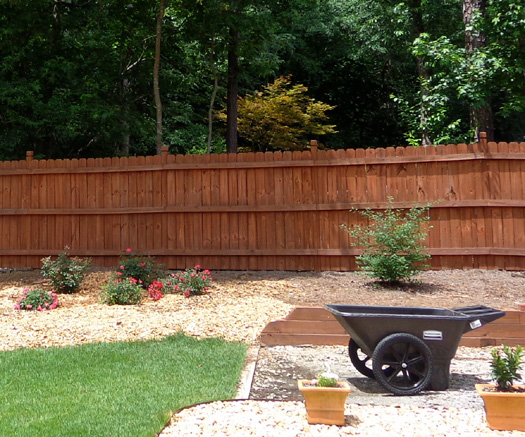
This large-capacity Rubbermaid garden cart with big wheels made
mulch-spreading
much easier than the small garden cart with little wheels we used for
many years.
When a neighbor had some trees cut down, we talked to the tree company
and found out they are happy to give homeowners the mulch when they have
a "clean" load.
We arranged for them to dump a huge truckload of "clean" mulch in our
driveway a few days later for only $50. It took us a total of about 20
man-hours to distribute all of it but with a new garden cart with large
wheels, the job wasn't too formidable and the yard looked better.
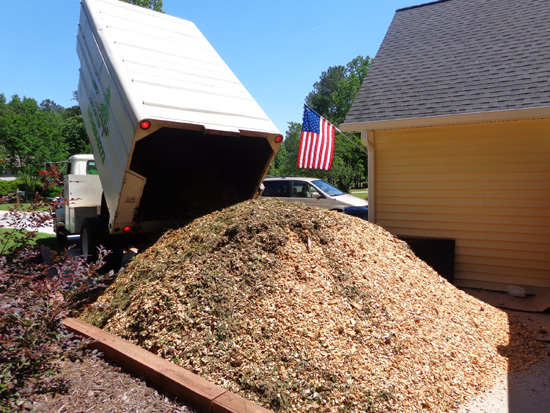
Above and below: Warning: the pile is
larger than it appears in these photos!
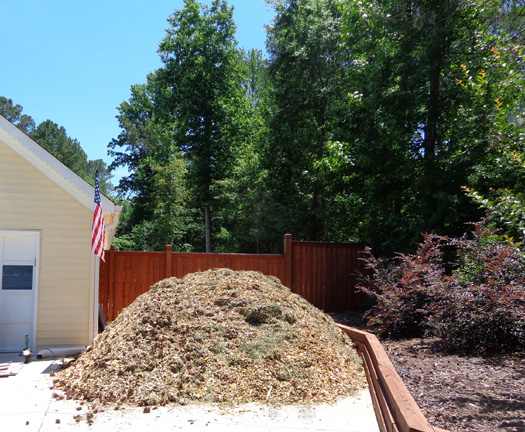
I knew we needed more mulch to make it thicker and to cover all the way
to the fence. So when Monster Tree Service called again a couple months later
to see if we wanted another load -- free, since they
initiated the call! -- from a huge oak tree they'd just cut down,
I said yes.
That brand new mulch
sure smelled good but we had smoke coming out from the pile until we
were able to move it all off the driveway -- it was wet when it
was cut, and burning! I had no idea that
was even possible. After a couple of rainfalls we couldn't tell that any
of the mulch had burned.
I think that's enough
mulch for one season . . .
POT WOMAN
One of the most fun projects I've had in the
back yard was designing and building a pot person. Since it looks more
like a pot woman so I named her Susie and put a garden hoe in one
of her hands.
I've never seen or even heard of clay pot people
until I saw one in the yard of a house that backs up to one of the
Kedron ponds. I'd walked, cycled, and ridden in our golf cart on the
multi-use path half a mile from our house several times before I spotted
one of the most interesting pieces of yard art that I've ever seen:
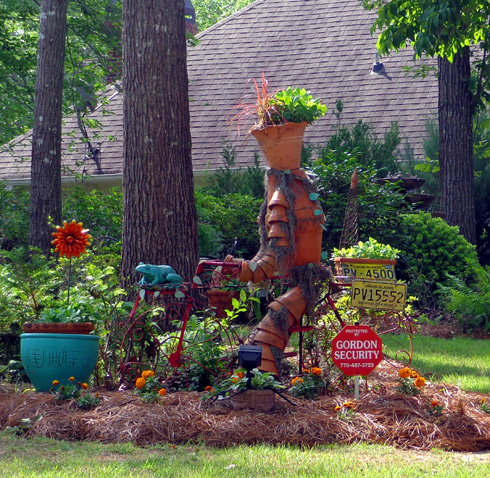
As soon as I saw it, I knew I had to have one in
my back yard, too.
Their pot person sits on a rusty old bike. I
didn't know where to find one of those so I imagined one in our yard
sitting on an old rusty garden bench.
I was too busy decorating the inside of the
house to spend time hunting for one of those so I ordered a
handsome new bench for only $62 from Wayfair.com -- and I'll let
it weather gradually. After it came Jim assembled it and sprayed it with
clear lacquer so it won't deteriorate for a while.
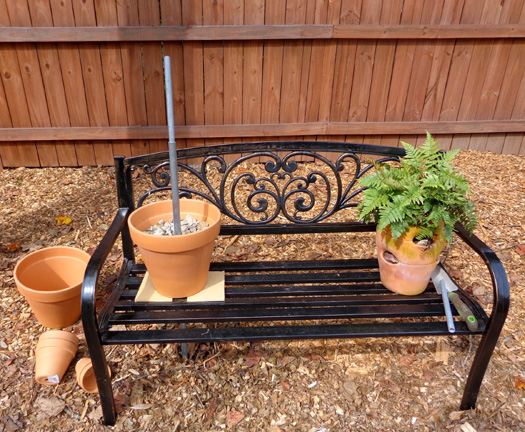
Handsome bench; beginning to build my pot person
with a steel rod and stones to anchor it.
Then I started researching clay pot people
online and found a treasure-trove of ideas on sites like
Pinterest
and the site in the quote at the top of this page.
I found
hundreds of examples -- small pot people, large pot people, painted pot
people, more rustic pot people, pot people standing, pot people sitting
on stumps, chairs, or shelves, pot people with various clothes or
accessories, even pot animals. (I might build a clay pot Labrador
retriever later!)
Some pot people were elaborate, some quite
simple. I wanted to keep mine rustic and simple. I drew a sketch in my
mind only, not on paper, and built it as I went, with few modifications.
I gradually assembled the clay pots I needed,
starting with two 12" pots for the torso and a strawberry pot with holes
in the side for the head. In all my online research I haven't seen a
strawberry pot used for the head but when I saw it at Home Depot, I
immediately saw two holes for eyes and one for a mouth!
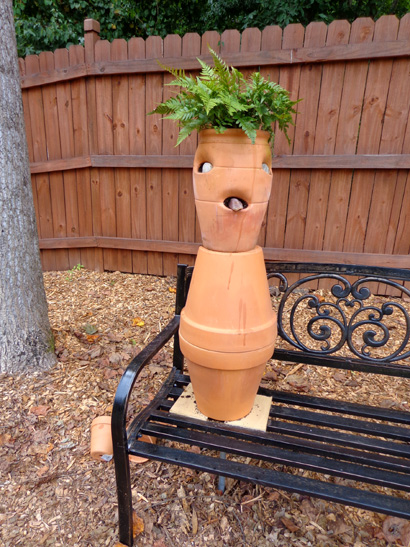
That was the most expensive part of the whole
figure. I brought home an 8" and a 6" pot to see if they'd be
proportionate for the arms and legs (yes), then purchased enough of each
size to get started.
Jim already had a piece of sturdy steel tubing
(next photo) that fit through the holes in the torso pots. I showed him where I
wanted the pot person to sit on the bench and he drove the tubing into
the ground to stabilize the upper body in case of high winds.
Then I filled in the two torso pots with small
rocks to support the heavy strawberry pot, which I filled with potting
soil and a fern to resemble hair.
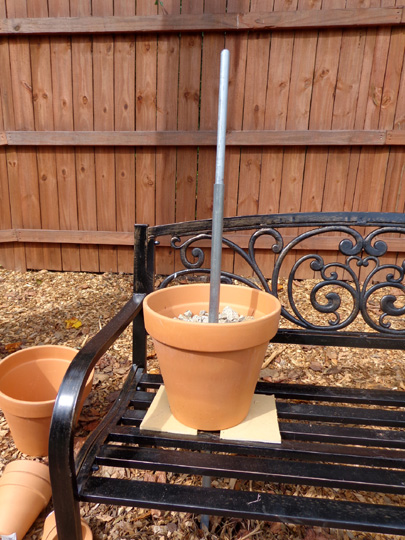
I found two round white rocks for eyes (might
paint them blue later on) and an oblong reddish rock for a tongue. I
poked them into the appropriate holes to resemble a face.
Folks use various methods to attach the arms and
legs to the torso. I tried styrofoam first, but it wasn't stable enough.
Then I used nylon rope, which is probably the most common method. I
wound it around the neck for the arms and the bottom of the torso pot
for the legs, then strung pots one at a time.
I knotted the rope between
each pot so they were spaced how I wanted them, then arranged the legs
and arms in a natural repose:
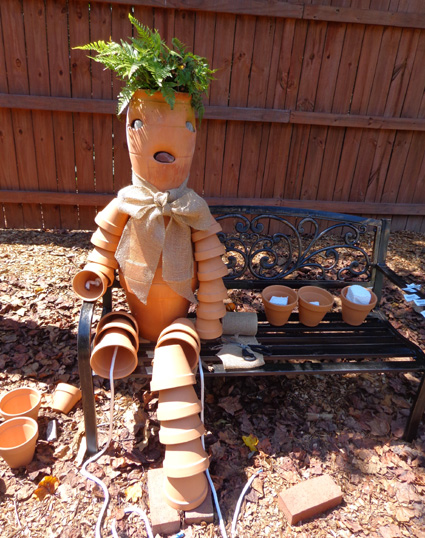

Last knot at
bottom of arm
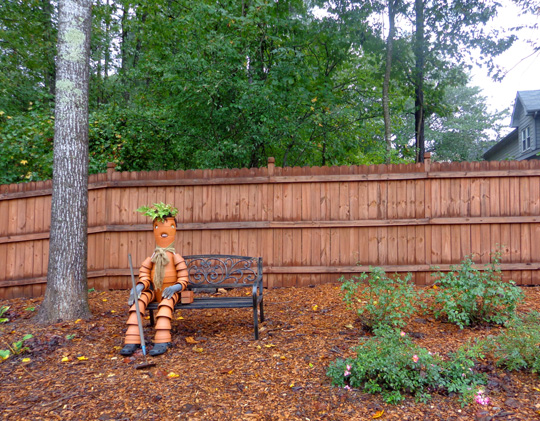
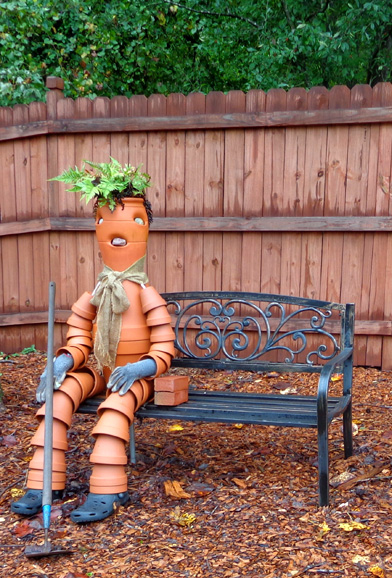
This area
gets shady by mid-afternoon in the summer so it's
a cool
place to sit by "Susie" and enjoy the rest of the yard.
Later I added some plastic sandals that Jim
never wears, some old garden gloves for hands, a burlap scarf around the
neck, and a garden hoe. It'll be fun to dress her up for
holidays.
I picked a location for the bench and pot person close enough to the
house so neighbors in the two-story houses around us can't see it. I
want it to be a private joke for us and our guests. I can also see it
from several places in our house; I smile every time I see it.
Next entry: scenes from Peachtree City -- cart paths, lakes, parks,
golf courses, critters, etc.
Happy trails,
Sue
"Runtrails & Company" - Sue Norwood, Jim O'Neil,
Cody, Casey, and Holly-pup
Previous
Next
© 2017 Sue Norwood and Jim O'Neil
